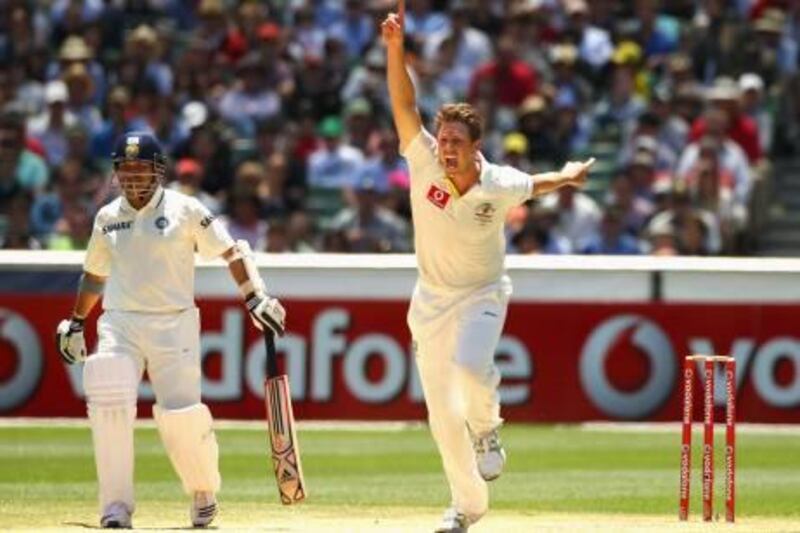If there is such a thing as a nailed-on certainty in a sport where fortunes can fluctuate wildly, it is that India will lose the Boxing Day Test at the Melbourne Cricket Ground.
The meek surrender on day four marked their fifth successive reverse, going back 20 years.
In that time, they have crossed 300 just once. When Australia's fielders crossed the rope yesterday morning with 292 to defend, you could understand the confident strut.
This MCG tale of woe is primarily a story of batting inadequacy, of techniques not grooved to cope with seam movement at high pace. VVS Laxman has an exceptional record in Australia, but averages just 14.25 at the MCG. Rahul Dravid, with one of the best techniques in the modern game, has crossed 50 just twice in eight innings there.
In those five losses, there have been just two centuries. When Virender Sehwag smashed 195 in five hours back in 2003, it should have been the spur for a famous victory. Instead, an all-too-familiar collapse saw Australia triumph by nine wickets.
Four years earlier, Sachin Tendulkar had made 116 (and 52), but with no other batsman crossing 45, Australia won by 180 runs.
That match saw the debut of Brett Lee, who tormented India with pace and accuracy, finishing with 7-78. More than a decade on, it was the turn of another wonderful pace prospect to bloody the Indian nose. James Pattinson's six wickets cost just 108, and he now has 20 wickets at 15.2 in his three-game career. Strongly built and aggressive, he and Pat Cummins - injured and not in contention for this series - hold the key to an Australian renaissance.
Pattinson was wonderfully supported in Melbourne, with Ben Hilfenhaus taking seven wickets on his return to the side, and Peter Siddle picking up six with the sort of whole-hearted effort that makes him a captain's favourite.
It could be argued that it was Siddle who broke the game open for Australia late on the second day. Tendulkar and Dravid had added 117, with Tendulkar looking especially fluent.
There were just four balls to go for stumps when Siddle got one to nip back off the seam and bowl Tendulkar. From a position of command at 214 for two, India folded for 282, with all three pace bowlers bowling fuller lengths.
The excellence of Australia's bowling has much to do with the man in the background.
Craig McDermott, who was appointed bowling coach last May, retired with 291 Test wickets, and Pattinson told a TV show last month of the influence that he had exerted on the quicks, both emerging and established.
"He [McDermott] has said to me that you've got more chance of getting wickets if you pitch the ball up there and give yourself a chance to get some caught behind," he said. "I had to get a lot fuller with my lengths and all that work I have done in Sri Lanka and South Africa has proved really good for me."
The same advice was given to Siddle, and it shouldn't be overlooked that Tendulkar, Sehwag, Dravid [twice] and Laxman all fell to the full delivery.
India won't panic just yet, but with Ajinkya Rahane and Rohit Sharma waiting in the wings, there will be immense pressure on Gautam Gambhir and Virat Kohli to make runs in Sydney.
Gambhir averages 32.06 in 18 Tests across the last two years, and his only century came against Bangladesh. His stellar partnership with Sehwag - they average 56.42 after 72 innings, with 10 century stands - has resulted in him being given a long rope but if he continues to dab at the ball well away from the body, he might share the fate of so many other openers jettisoned after poor tours of Australia.
It is hard to criticise India's bowlers after they dismissed Australia for 333 and 240. Umesh Yadav was a little too short at times in the first innings, but learnt quickly, while R Ashwin struggled at times with his length in the second innings.
The main concern though was the inability to snip the Australian tail, with the last two wickets adding 116 over the two innings.
Some of the blame has to go to MS Dhoni, and fields so defensive that singles were a given each time the ball was played off the square. Those tactics will need to be revisited before Sydney.
That these are back-to-back Tests is probably a blessing, with no time to brood over yet another Boxing Day knockout.
@ For more on AUSTRALIA, visit thenational.ae/topics





